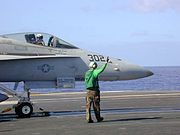Though the YF-16 won the LWF competition, the Navy was skeptical that an aircraft with one engine and narrow landing gear could be easily or economically adapted to carrier service, and refused to adopt an F-16 derivative. The Navy fought for and won permission to develop an aircraft based on the YF-17. Since the LWF did not share the design requirements of the VFAX, the Navy asked McDonnell Douglas and Northrop to design a new aircraft around the configuration and design principles of the YF-17. The new aircraft, designated the F-18, shared not a single essential dimension or primary structure with the YF-17. Secretary of the Navy W. Graham Claytor announced on 1 March 1977 that the name of the aircraft would be "Hornet".

Northrop had enlisted the aid of McDonnell Douglas as a secondary contractor on the NACF proposal to capitalize on the latter's extensive experience in building carrier aircraft, including the highly successful F-4 Phantom II. On the F-18, the two companies agreed to split the parts manufacture evenly, with McDonnell Douglas completing the final assembly, representing ~20% of the work. McDonnell Douglas built the wings, stabilators, and forward fuselage; Northrop built the center and aft fuselage and vertical stabilizers. McDonnell Douglas was the prime contractor for the naval versions. Northrop would become the prime contractor and take over final assembly for the F-18L land-based version which Northrop hoped to sell on the export market.
The F-18, initially known as McDonnell Douglas Model 267, was drastically modified from the YF-17 while retaining the same basic configuration. For carrier operations, the airframe, undercarriage, and arrestor hook were strengthened, folding wings and catapult attachments were added, and the landing gear widened. To meet Navy range and reserves requirements, McDonnell increased fuel capacity by 4,460 pounds (2,020 kg), with the enlargement of the dorsal spine and the addition of a 96 gallon fuel cell to each wing (the YF-17 had dry wings). Most visibly, a "snag" was added to the leading edge of the wings and stabilators to prevent a flutter discovered in the F-15 stabilator. The wings and stabilators were enlarged, the aft fuselage widened by 4 inches (102 mm), and the engines canted outward at the front. These changes added 10,000 lb (4,540 kg) to the gross weight, bringing it to 37,000 lb (16,800 kg). The computer-assisted control system of the YF-17 was replaced with a wholly digital fly-by-wire system with quadruple-redundancy, the first to be installed in a production fighter.
